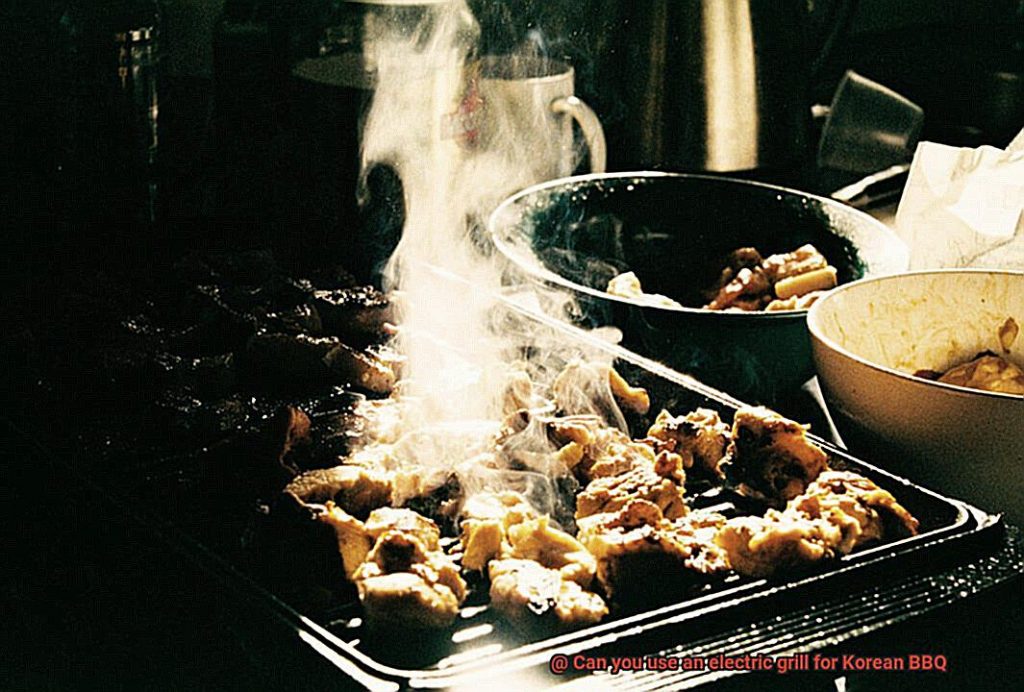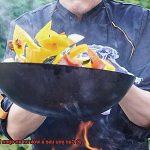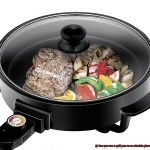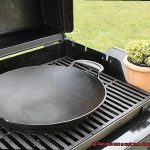Are you a fan of Korean BBQ? The delicious combination of savory and sweet flavors is enough to make anyone’s mouth water. But what if you don’t have access to a traditional grill? Can you use an electric grill for this popular cuisine?
Electric grills are becoming increasingly popular, especially among city-dwellers in small apartments who crave the taste of grilled food. And let’s face it, they’re versatile gadgets that can cook just about anything. But can they create the authentic Korean BBQ taste that you’re craving?
In this article, we’ll explore the ins and outs of using an electric grill for Korean BBQ. From the differences between traditional and electric grills to tips on how to prepare your meat for the perfect Korean BBQ, we’ve got you covered. So whether you’re a seasoned pro or a first-time griller, read on to discover all you need to know about making Korean BBQ on your electric grill.
Contents
Advantages of using an Electric Grill for Korean BBQ
If you love Korean BBQ but are tired of the smoke, mess, and inconvenience of traditional grilling methods, an electric grill may be just what you need. While some may argue that the smoky flavor of charcoal or gas grilling is essential to Korean BBQ, electric grills offer many advantages that make them a valuable option for your next Korean BBQ feast.
Firstly, electric grills are incredibly convenient and easy to use. Unlike traditional charcoal grills, there is no need to wait for coals to heat up or deal with the hassle of ash and smoke. Simply plug in your grill, set the temperature, and start grilling. This is especially helpful for those who live in apartments or urban areas where traditional grilling may not be an option.
Another significant advantage of electric grills is temperature control. With precise temperature settings, you can prevent overcooking or undercooking your meat, which can be a lifesaver when grilling thin slices of meat like bulgogi or galbi. This ensures that your meat stays tender and juicy every time.

In addition to being a convenient and precise cooking method, electric grilling can also be healthier than traditional grilling. Electric grills produce less smoke and grease than charcoal or gas grills, making for a more comfortable and cleaner cooking experience. Some electric grills even come with drip trays to collect excess fat and oil, allowing you to cook leaner meats without sacrificing flavor.
Electric grills offer versatility in terms of where and how you can use them. They can be used both indoors and outdoors, making them ideal for year-round grilling no matter the weather. Plus, they come in various sizes and shapes, so you can choose one that best fits your needs and space.
Last but not least, electric grills tend to be more cost-effective in the long run than traditional grills. While some high-end models can be expensive, there are many affordable options on the market that offer excellent performance and durability. Additionally, electric grills are more energy-efficient than gas or charcoal grills, which can save you money on your utility bills over time.
Disadvantages of using an Electric Grill for Korean BBQ
While it may seem like a convenient option, there are some important things to consider before making the switch. Here are the disadvantages of using an electric grill for Korean BBQ:
Firstly, the lack of smoky flavor. One of the biggest drawbacks of electric grills is that they cannot produce the same smoky taste that comes with charcoal grilling. This is because electric grills do not generate as much heat as charcoal grills, which means that your meat won’t get charred in the same way. If you’re a fan of the traditional Korean BBQ taste, then an electric grill might not be the best option for you.
Secondly, efficiency. Electric grills can be less efficient than charcoal grills because they take longer to heat up and may not reach the same high temperatures. This can result in longer cooking times and inconvenience when you want to cook your food quickly.
Thirdly, limitations on cuts of meat. Thicker cuts of beef or pork may require higher temperatures and more direct heat than an electric grill can provide. This can lead to unevenly cooked meat or meat that’s not fully cooked through, which could pose health risks.
Lastly, cleaning can be more difficult. Electric grills have more parts and non-stick materials that can be sensitive to harsh cleaners. Additionally, the fat and juices from your meat may not drain away as well on an electric grill, leaving you with a messy cooking surface to clean up.
Selecting the Right Type of Meat for Korean BBQ
It’s the first step in achieving that sweet, savory flavor that makes Korean BBQ so irresistible. But with a plethora of options to choose from, it can be overwhelming to pick the perfect cut. Don’t worry, I’m here to help you navigate the meat maze and make the most of your BBQ experience.
Let’s dive into beef. Beef brisket is a favorite in Korean BBQ due to its rich flavor and tenderness when cooked correctly. Ribeye, sirloin, and short ribs are also popular choices that provide a juicy, flavorful alternative. For a more adventurous twist, try pork belly – a staple in Korean BBQ known for its crispy exterior and juicy interior. Other pork cuts such as shoulder and loin can also be used to shake things up.
Chicken lovers rejoice. Thighs and wings are the go-to choices for Korean BBQ due to their high-fat content that keeps the meat moist on the grill. And for seafood enthusiasts, shrimp and squid are often used in Korean BBQ for a delicious twist.
But wait, there’s more. The quality of the meat is just as vital when it comes to achieving that perfect Korean BBQ flavor. Purchase high-quality cuts from a reputable butcher or retailer for top-notch results. And for an extra kick of flavor and tenderness, marinate your meat before grilling.
Marinating for Flavor Enhancement
Marinating for flavor enhancement is the secret ingredient to achieving that perfect, mouth-watering Korean BBQ experience on your electric grill. As an expert on the topic, I can tell you that marinating is a crucial step that helps tenderize the meat, add moisture, and infuse it with delicious flavors.
To start off, choosing the right cuts of meat is essential. Thin slices of beef or pork are ideal for Korean BBQ as they absorb the marinade well and cook quickly. Popular options include ribeye, sirloin, brisket, and pork belly. Investing in high-quality cuts from a reputable butcher or retailer will elevate your Korean BBQ game.
Now onto the star of the show – the marinade. A delicious marinade typically includes soy sauce, garlic, ginger, sugar, sesame oil, and other spices. It’s important to strike a balance between flavor and not overpowering the natural taste of the meat. I recommend a ratio of one part soy sauce to one part sugar with garlic and ginger added to taste.
Marinating is especially important when using an electric grill as it tends to dry out meat quickly. Marinating helps keep the meat moist and juicy during cooking while infusing it with all those delicious flavors that we love about Korean BBQ.
When preparing your marinade, ensure that every part of the meat is covered with it by placing it in a resealable plastic bag or container. Let it sit in the refrigerator for at least 30 minutes or up to 24 hours for maximum flavor enhancement. Trust me; patience pays off.
Adjustable Temperature Controls and Smoke Boxes
Fortunately, electric grills make this achievable with the help of adjustable temperature controls and smoke boxes.
Let’s dive into what makes adjustable temperature controls so crucial. When cooking meat, having the ability to adjust the temperature ensures that it is cooked evenly and doesn’t dry out. Whether you’re grilling thin slices of beef or thick cuts of pork belly, precise temperature settings are essential for achieving mouth-watering perfection.
Now let’s talk about smoke boxes. While electric grills may not produce as much smoke as charcoal grills, some models come with smoke boxes that allow you to infuse your meat with delicious smoky flavors. Simply fill the box with wood chips or other smoking materials and place it on the grill for an elevated and flavorful Korean BBQ experience.
It’s important to note that not all electric grills are created equal. When shopping for an electric grill specifically for Korean BBQ, it’s crucial to look for models that have adjustable temperature controls and smoke boxes. These features will ensure that you are able to achieve the best possible cooking experience.
But don’t let purists dissuade you from using an electric grill. While some may argue that charcoal is the only way to achieve authentic Korean BBQ, an electric grill with adjustable temperature controls and smoke boxes can produce equally delicious and flavorful results.
Experiment with different techniques and find what works best for you – after all, cooking is all about creativity and exploration.
Tips and Tricks for Grilling with an Electric Grill
Grilling is a great way to cook meat, and Korean BBQ is no exception. If you have an electric grill at home, you can still achieve that authentic taste and texture with a few tips and tricks.
Choose the right type of electric grill
When it comes to cooking Korean BBQ on an electric grill, it’s important to choose one with a high temperature range. This will allow you to sear the meat properly and create that crispy exterior that is characteristic of Korean BBQ.
Use a cast iron grill pan or griddle
To prevent the meat from sticking and distribute heat more evenly, consider using a cast iron grill pan or griddle instead of the standard grates that come with the electric grill.
Marinate overnight
Marinating the meat overnight is essential for achieving that delicious Korean BBQ flavor. You can use a traditional Korean marinade such as bulgogi sauce or kalbi marinade, or make your own using soy sauce, garlic, ginger, and sugar.
Preheat your grill
Before adding the meat, preheat your grill for at least 10-15 minutes to ensure even cooking and prevent sticking.
Avoid overcrowding your grill
Make sure not to overcrowd your grill, as this can cause uneven cooking and may lead to undercooked or overcooked meat. Instead, cook in smaller batches and keep finished meat warm in a covered dish while you finish cooking the rest.
Don’t forget to be patient and take your time while grilling. Use tongs to flip the meat frequently and keep an eye on its progress to prevent overcooking. And don’t be afraid to experiment with different marinades and sauces to add your own personal touch to this classic dish.
The Benefits of Charcoal or Gas Grills
If you’re a grill master, you’ve probably wondered whether charcoal or gas grills are better. As an expert, I can tell you that both types have their advantages, and it all comes down to your personal preference. Let’s take a closer look at the benefits of each type of grill for cooking in general and specifically for Korean BBQ.
First, let’s talk about charcoal grills. If you’re a purist who loves the smoky flavor of grilled meat, then charcoal is the way to go. Plus, they’re typically less expensive than gas grills and can reach higher temperatures for perfect searing. However, they do take longer to heat up, and cleaning them can be a bit of a hassle.
On the other hand, gas grills are known for being convenient and easy to use. They heat up quickly and allow for precise temperature control, which is great for cooking delicate foods like fish and vegetables. And they’re much easier to clean than charcoal grills. However, they tend to be pricier and don’t provide the same smoky flavor that charcoal grills do.
Now, let’s talk about Korean BBQ specifically. Traditionalists will insist on using a charcoal grill because it’s essential to achieving that smoky flavor that makes Korean BBQ so delicious. But if you don’t have access to a charcoal grill or just prefer the convenience of gas, it’s still possible to achieve great results with a gas grill.
1PGpp5v5OyE” >
Conclusion
In conclusion, the verdict is in: electric grills are a fantastic option for Korean BBQ. Not only do they offer unparalleled convenience and precision temperature control, but they also provide versatility in terms of where and how you can use them. However, it’s important to keep in mind that there are some potential downsides to using an electric grill, such as the absence of smoky flavor and limitations on certain cuts of meat.
To ensure that your Korean BBQ experience on an electric grill is top-notch, selecting the right type of meat and marinating it overnight is crucial for maximum flavor enhancement. Additionally, utilizing adjustable temperature controls and smoke boxes can help achieve that authentic taste and texture that makes Korean BBQ so irresistible.
While purists may argue that charcoal is the only way to achieve truly authentic Korean BBQ, an electric grill with adjustable temperature controls and smoke boxes can produce equally delicious and flavorful results. By following a few key tips – like choosing the right type of electric grill, using a cast iron grill pan or griddle, preheating your grill properly, avoiding overcrowding your grill, and experimenting with different marinades and sauces – you can take your Korean BBQ game to new heights on an electric grill.
Ultimately, whether you prefer an electric grill or a traditional charcoal or gas grill comes down to personal preference. Both types have their pros and cons when it comes to cooking in general and specifically for Korean BBQ.






